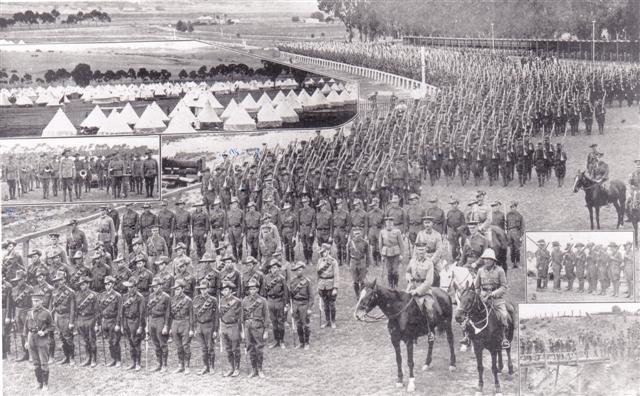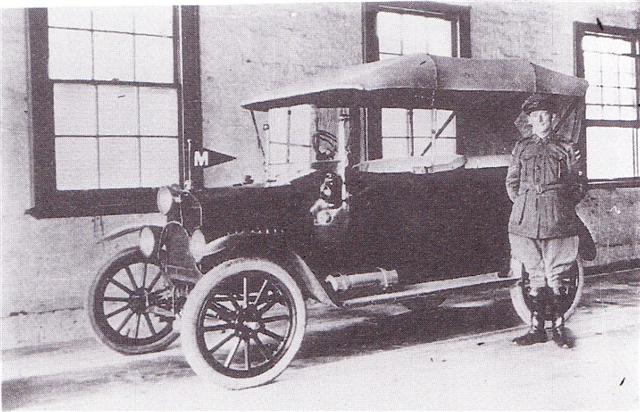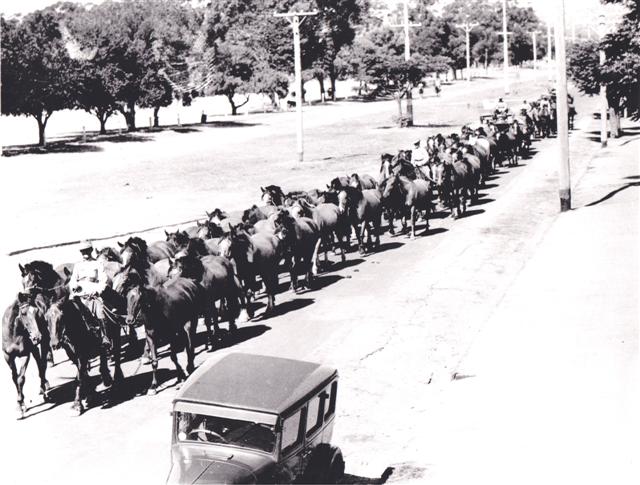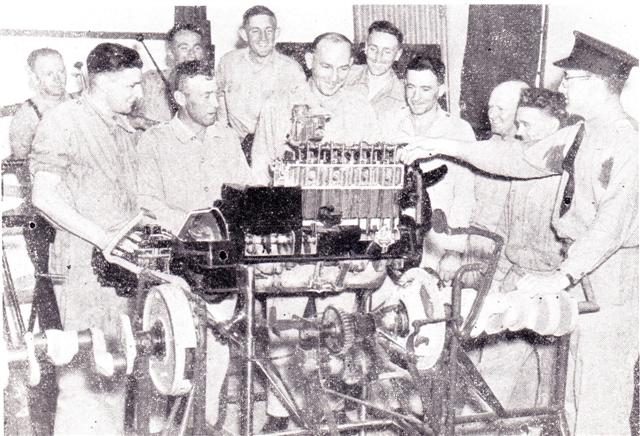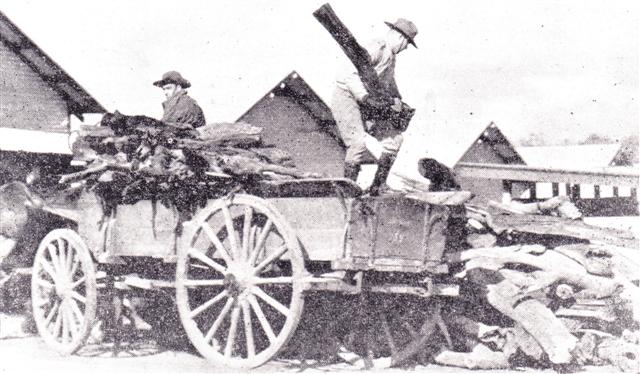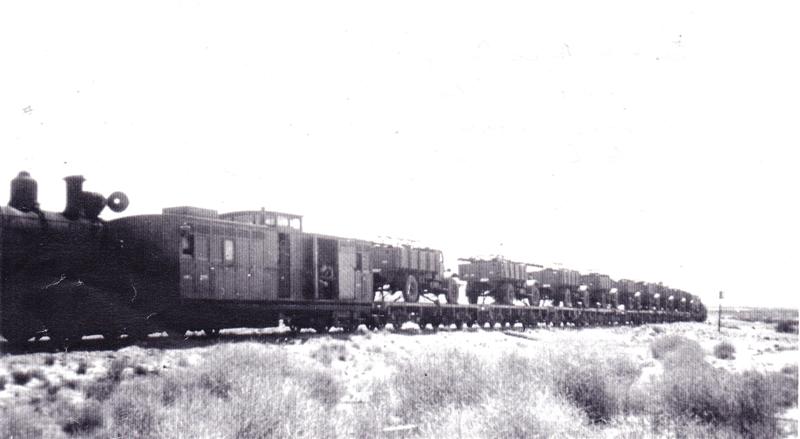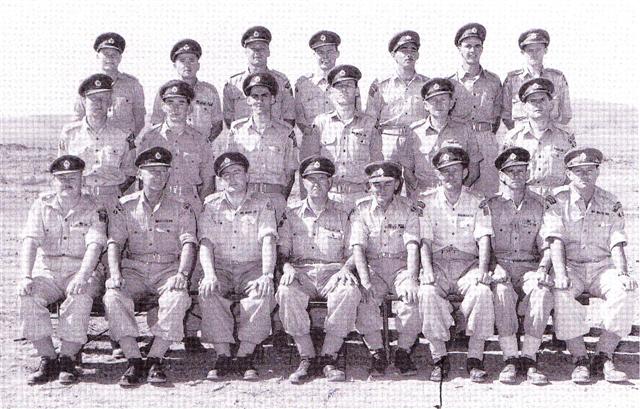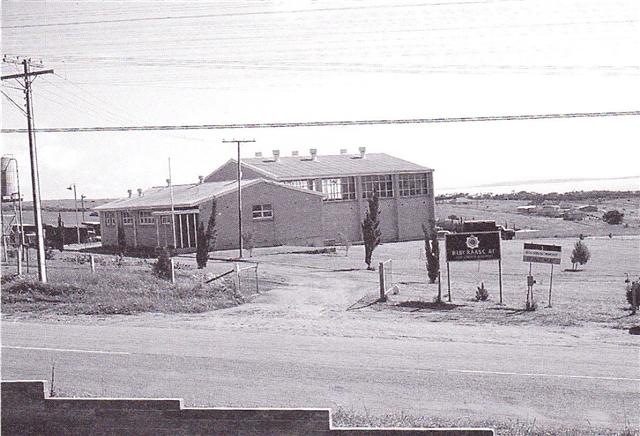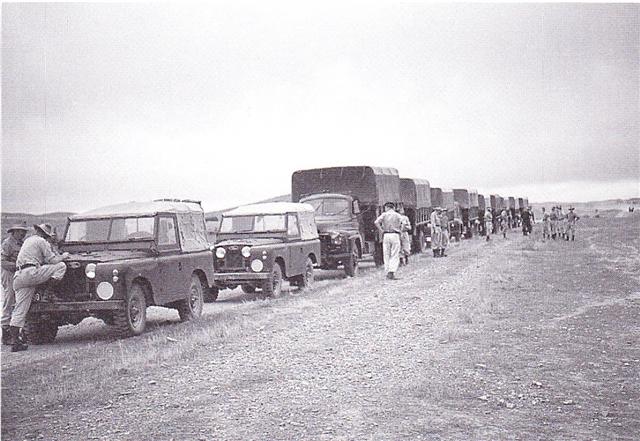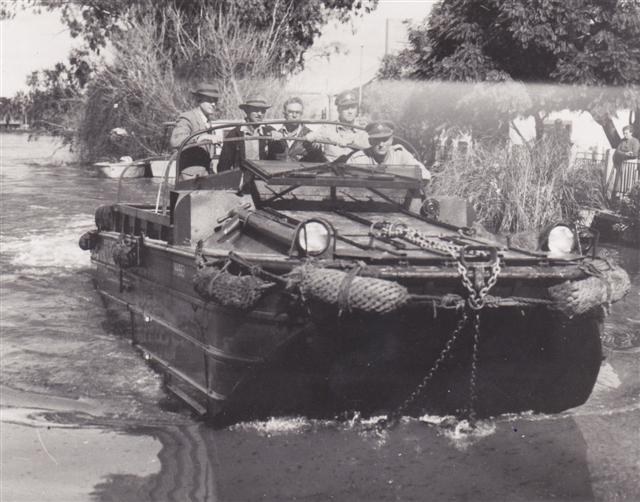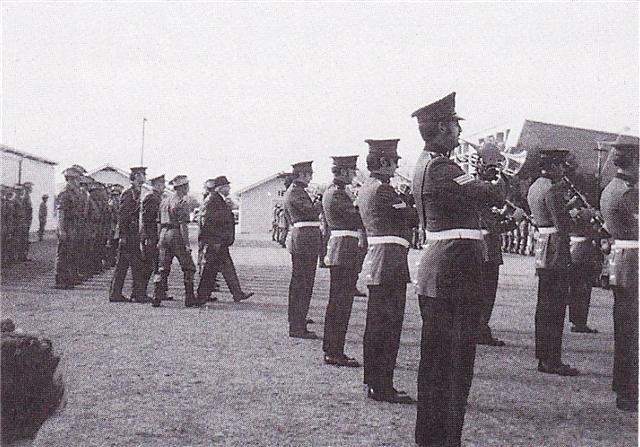Chapter 9
The Corps in South Australia
Raising an AASC Component
South Australia had indeed made tentative provision for an Army Service Corps in its Military Forces Regulations of 1895 but, as had happened in Queensland, had not allotted the priority for funds and manpower which would have translated good intention into reality. This inertia was carried through to the Commonwealth Forces to a broader degree than just the supplies and transport field, and in consequence the South Australian forces in 1902 did not stand high in the estimation of GOC Sir Edward Hutton as he watched their strength waste away by almost half during his time in office. He was therefore quite happy to defer raising the planned Militia light horse brigade and both the light horse brigade supply column and AASC Garrison Details until the national financial and local military situations were more propitious 1. Authority for the eight-man Militia garrison details of a lieutenant, sergeant, corporal and five private soldiers was given in 1905, and it had eight men supporting the garrison camp in 1906 and following years, a newspaper report of the 1907 Easter Camp noting that 'Captain Esselbach has his indefatigable Army Service Corps in harness and that is a guarantee of comfort’ 2. It was not until 1909 that approval was given for 6 LH T&S Col to be raised at the restricted strength in Appendix 3, and the unit was not operative until the following year when 34 from the Column and Garrison Details attended camp at Smithfield 3.
This had been a slow start indeed, coming shortly before the Universal Training expansion which required first the split of 6 LH T&S Col and the Garrison Details into 19 Coy for 19th Brigade and 31 Coy for 8th Light Horse Brigade, and then the raising of 20 Coy for 20th Brigade. Manning at soldier level relied on no more than accepting the annual cohorts of Senior Cadets who had received a reasonable level of basic training, but technical and tactical training, and more importantly real supply and transport support, depended on the capability of the officer and NCO cadre from the previous Militia units, themselves so recently expanded, and the single Permanent warrant officer allotted to the instructional staff 4. There was, however, a bonus for South Australia in that the DAQMG on HQ 4 MD was Maj A.P. Luscombe who, as a special service officer in the Boer War, had commanded 33 Coy ASC in operations. As well having being appointed as a supernumerary Inspector for AASC for the Inspector General, he was also able to assist the fledgling South Australian companies meet the demands of their rapid expansion 5. And the problem for the AASC was that, although each other arm of the Army had similar expansions to meet, its companies had to actually carry out their function in a real sense: while a light horse, infantry or artillery unit might perform indifferently in camp or exercise, this was a normal and accepted matter of learning lessons and corrective training, but for the AASC any failure would have had an immediate and tangible effect on supported troops and activities and simply could not be contemplated much less tolerated.
Supply of horses to the expanding force was also a growing problem, but fortuitously a Permanent remount section of eight had been formed in 1912 to operate remount depots, first at Glenthorne, which was also a farm and breeding station, and then at Keswick. These were able to keep up with the demand for horses able to perform during artillery and other training in camp rather than the previous situation of using camp to train hired horses. As a side issue on the motor transport front, a section of the Australian Volunteer Automobile Corps was started at Keswick in 1908 with five members, expanding to seven, but wasting down to three by 1914 as their role tended to be diverted to providing transport for staff officers 6.
The AASC Garrison Details and subsequently 6 LH T&S Col supported annual camps at Smithfield, but the expansion from 1912 extended this to cover Fort Largs, Reynella, Kapunda, Gawler, Jamestown and Bordertown 7. To some degree the AASC was fortunate that the South Australian population was so concentrated that 19, 20 and 31 Coys were largely able to have unit camps in which to carry out some degree of progressive technical training which also helped them over the expansion hump. Remote from the Permanent Section instructional cadre in Sydney, and without an ADS&T up to the beginning of the war, they had their problems, but surmounted them effectively enough to continue their dual tasks.
On The Home Front
South Australia's contribution to the AIF began with a section of 4 Coy of 1 Div Train and an element of 10 Coy (1 Res Park) which, with contingents from other states, were concentrated for training at Broadmeadows and departed Melbourne at the end of October with the first convoy on Geelong and Armadale. In the second convoy were a section of 9 Coy (1 Div Sup Col), elements of 13 Coy (1 Fd Bky, 1 Fd Bchy) and 1 DUS of 11 Coy. Capt L.S. Sando raised 14 Coy (4 LH Bde Train) at Mitcham after which it moved to Broadmeadows for embarkation on Afric in May. Other contributions to go in later 1915 were elements of 19 Coy (3 Fd Bky, 3 Fd Bchy), 6 DUS of 21 Coy, and 3 Sqn of 1 Remount Unit which was made up of horsemen largely over age for normal overseas service 8. Subsequent drafts comprised replacements for those units or general reinforcements.
The promise of an ADS&T remained unfilled until immediately before the war when Lt N. Marshall was appointed, barely in time to organise the assembly, accommodation and movement of the various South Australian contingents for concentration and shipment overseas. The AIF training camp at Mitcham was staffed by AIF recruits and sub-units in transit augmented by home service AIF volunteers, and Militia camps continued with little difference from the pre-war ones, except for the occasional call outs designed to pressure conscriptees into volunteering for the AIF. The Militia was well enough able to deal with both assistance to the AIF camp and its own training: it remained as 19, 20 and 31 Coys until the 1919 reshuffle renamed them 14, 25 and 31, with 6 Coy at Port Adelaide added in the postwar bulge in 1920 9. There was a minor gain with the redundant Volunteer Automobile Corps transferred in 1916, and some losses to the AIF, particularly in the emotional response to the Gallipoli and Somme battles of 1915 and 1916. But from thereon it tended to stabilise and finally show net increases from successive Cadet inflows and dwindling enthusiasm for overseas service towards the end of the war. Returning rehabilitees from the front added to the instructional cadre to improve training of home forces which were not going to fight any war, but at least were going to share some of the discomfort if they chose not to volunteer for overseas service. A drive in 1917 to resuscitate a flagging Militia was of comparatively little relevance to the AASC companies which, although without the objective of preparing for a live war, at least had the tangible test and incentive of providing live support to training camps, a reality which saved them from the backwater mentality of the fighting arms units which had no prospect of carrying out their real role once the conscription referendums failed.
Between Wars
The South Australian apportionment in the 1921 reorganisation of the Militia was 4 Coy of 2 Cav Div Train and 4 Coy of 4 Div Train, with a HQ AASC added for local command and training purposes, commanded initially by Lt-Col F.L.L. Henley DSO OBE, sometime CO of 3 Div Train in France, then successively from 1922 Capt H.C.W. Harrison OBE, 1926-36 Capt W. Hocking, again a case of badly over-extended tenure of command, then Lt-Col W. Susman 10. While giving the fourth companies of a cavalry and infantry divisional train to each of Queensland and South Australia may have seemed a neat and balanced slice to an Army Head-quarters staff officer, it was a silly confusion to have two companies of the same number in the one city, especially when there was no particular local affiliation with that company number. Indeed affiliations were entirely forgotten – both with previous Militia units which had existed locally, and with the AIF companies which, having had distinguished service in action, were buried in an anonymous numerical repetition in each division.
Reality for the Army in an arms reduction environment and a reduced Universal Training commitment meant a reduced Citizen Force, where volunteers were discouraged by a conscription environment and conscriptees were limited by a shortened service liability. Fortunately the majority of officers were businessmen who were able to induce men of the right type to enlist, so this numbers game had a minimal effect on the two 4th Companies in a phenomenon which was a constant throughout AASC's existence in the State, demonstrating clearly that units with a real job to do and halfway effective leadership have no difficulty in getting members. This basic truth was reflected in later times, hard and easy, under both conscription and volunteer regimes after World War 2, when AASC units were at effective and sometimes over-strength while adjacent units with apparently more glamorous roles were starved for manpower.
From 1929 the abolition of conscription and reduction of training time struck hard, and was accompanied by a reorganisation. In the interim restructuring of 1928 towards the revised RASC divisional ASC structure, the two companies were each renamed from 4 Coy to D Coy, and a field Horse Transport Company and 1, 2 and 3 Depot Sub-Sections were raised. As the reorganisation was consolidated to the divisional two-company structure, this was replaced in 1930 by renaming them as D Sections of each of the Divisional Supply Companies and Horse Transport Companies of 2nd Cavalry and 4th Divisions 11. South Australia now had four units of the same designation located at Keswick Barracks – the new sections approximated to the previous company size and the Depot Sub-Sections had been abolished, their functions absorbed into the supply company sections. Failure to address mechanisation left the units just one step ahead of their pre-war status: the wagons built during the war in quantity were still freely available, however the horses to draw them were another story, as economies had prevented the Remount Service from replacing horses well past their normal working life.
After the 1933 mechanisation decision the Horse Transport companies of the divisions were redesignated Mechanical Transport. In South Australia the supply and horse transport sections were consolidated into a Supply Company and an MT Company, commanded by HQ AASC Fd Tps 4 MD, the Field Troops designation filling in the awkwardness of companies nominally for divisions supporting the two brigades in 4 MD. Equipment of the MT Company was equally awkward, with a grand total of three Iorries allocated for training. In the 1938 reorganisation, regressing further to a commodity structure of divisional supply columns and ammunition companies, the Supply Company was remade into 3 Bde Sup Coln to support 3rd Mixed Brigade and the MT Company replaced by the earlier sections from interstate divisions: C, F Secs of 1 Cav Div Sup Coln, matching the 6th Light Horse Brigade of 1st Cavalry Division located in the State, and B Sec 4 Div Amn Coy which latter was placed with 3 Bde Sup Coln under HQ 3 Bde AASC to make a balanced AASC component for the brigade. HQ AASC Fd Tps remained in overall command of the 3rd Brigade AASC units and C and F Secs of 1st Cavalry Division 12. Confusing? – once again the byzantine twists in allocation of units to ensure retention of major headquarters in Melbourne and Sydney are highlighted.
From the 1921 reorganisation, 4th District Base included the Permanent Supply and Transport Section, headed by an unposted Staff Officer Supply and Transport replacing the unposted ADS&T position, and containing a small Horse Transport Section for local tasks plus the Remount Section to supply horses to the Permanent artillery and services, and to Militia camps. ln 1927 the staff establishment of 4th District Base was augmented with a DADS and a DADT(MT) in recognition of the intention to establish supply depots and motor transport in the district bases, but the only outcome was appointment of Militia officer Capt H.S. Susman as DADS to cover the continuing absence of a Permanent staff officer. Depression economies saw any further intent delayed until 1934 when, in the general quickening of interest in Defence, things actually began to happen. This happening was the appointment of Lt R.M. Lenton as SO S&T who continued as ADST through the war years, and the expansion of the Permanent MT Section, followed in 1938 by the Militia 7 Sup Pers Coy, which put the Supplies and Transport Service in a position to handle the domestic requirements of the Army in the State, and also provide a cadre on which to expand in war. The Remount Section continued to operate the base 9th Remount Depot at Glenthorne with the working 10th Remount Depot at Keswick. As the Army built up in the late 1930s, so did the horse requirement, and a Militia 4 Remount Tp was also raised in 1938 to cope with the horses required for camps; additionally 14th Remount Depot was established as a working depot at Woodside to service the camps now held there 13. The AASC in 4 MD was now ready to contribute to an apparent re-run of World War 1.
In The Home Base
While the outbreak of war on 3 September 1939 brought the call out of the Militia as elsewhere, South Australia was never seriously considered to be in the front line as were most other areas at some time. It served as a training and base support area, and had its share in raising units for the AIF. C Section of 6 Div Amn Coy and the Workshops of 6 Div Pet Coy were formed at Wayville Showgrounds in November, moving to Woodside for infantry training until they were able to borrow some trucks from the artillery units and begin transport training and tasks. they joined their parent units at Seymour in December, leaving for the Middle East in April 1940 with the 18th Brigade convoy which was diverted to England. In May 1940 Capt T.C. Williamson raised 7 Div Pet Coy from a mixture of Militia and civilian recruits, and in June the transport section of 2/6 Fd Amb was organised from Militia and Permanent members; these units left for Melbourne and the Middle East in October; the other AIF contribution for overseas was the transport section of 2/8 Fd Amb raised in July 1940 and sent to Malaya the following year. But South Australia's principal ongoing function was as a transit area to the West and to the Northern Territory although this did not inhibit the formation of a Militia field force based on 6th Cavalry and 3rd Infantry Brigades as the covering force for 4 MD defensive operations. It included, up to the restructuring and reallocation after the Japan's entry into the war, HQ 4 MD AASC with under command units whose titles changed marginally but ended as 6 Cav Bde Coy, 6 Cav Fd Amb Tpt Sec, 4 MD Sup CoIn, 4 MD Amn Sec and 4 MD Pet Sec, with 4 MD Amn Sub-Park, 4 MD Pet Sub-Park, 4 MD MAC Transport Wing, 8 Res MT Coy and 7 Sup Pers Coy as the corps troops slice 14.
At the outbreak of war, mechanisation plans established a need for acquisition of large numbers of civilian vehicles. To this end AASC provided 4 MD (7th) Vehicle Collection Centre in which called up soldiers accepted called up vehicles at locations throughout the District, where they were assessed, painted and brought to satisfactory mechanical condition for issue to units. Similar action for the horse requirement saw a purchasing board, including OC of the Remount Section Maj F. Cawley MC, acquire horses which were dispatched to the remount depot for similar preparation. For the horsed days were by no means over: 8 Aux HT Coy was raised and operated as base transport until 1944, while hospitals and internment camps used wagons as domestic transport until the end. Other base units included 5 Amb Car Coy to provide ambulances for the military hospitals, and 4 BIPOD and 4 MD Bulk Pet Storage Coy to hold and issue District petroleum stocks in the fuel rationing environment 15.
Further changes saw 8 Res MT Coy renamed 108 Res MT Coy then 121 GT Coy, while the field troops AASC HQ, Sup Coln, Pet and Amn Coys were amalgamated into 122 GT Coy; both of these were later dispatched to the Northern Territory as part of the road line haul force from Alice Springs to Larrimah. In reverse 147 GT Coy, when released from the Northern Territory, became the mainstay of transport support in the base structure. Local base supply units were established to service the military population of the District, which was renamed SA L of C Area, then again 4 L of C Area in 1942: DSD Smithfield-Terowie, 4 Fd Bch Coy and 9 Fd Bky; 4 BIPOD became SA L of C Area then 4 L of C Area BIPOD as fashions changed; and rationalisation of supply units in April 1943 replaced them with 13 and 14 Sup Dep Coys commanding 81-89 Sup Dep Pls. This group of units existed both for the base area, RAAF, hospital and prisoner of war camp liability and for the transit requirement to and from Darwin and Perth. The base units also hived off units to the expanding New Guinea Force, a platoon of 6 Pack Tpt Coy and four sections of 7 Sup Pers Coy moving north in 1942, 89 Sup Dep Pl and a substantial component of 2 Bulk Pet Storage Coy in 1943, as well as the various reinforcement drafts passing through the basic training system for the mainstream AASC units of 1st Army 16.
Even though mechanisation was tackled seriously from the beginning of World War 2, the Remount Service expanded to match the expansion of activity and the decision to retain horse transport to economise on strategic materials. The Remount Section and its supporting Militia 4 MD Remount Tp under DADR Cawley went into camp at No 14 Remount Depot Woodside in October 1939, their stock in trade expanded to 240 horses of which 90 were trained to GS wagons. The following month some of the members had to return to Glenthorne to take in the harvest of 306 tons of hay the planting of which, to the tune of 150 acres a year, continued until the end of the war. Expansion of horse transport use during 1941 increased holdings to over 600 horses, and in February 1942 the two units were amalgamated into 4 Remount Sqn, continuing to operate 9 and 14 Remount Depots, with Lieut (later Capt) G.O. Cundy taking command and DADR 4 L of C Area in July. In August the desperate supply situation in the Papuan campaign called for expansion of pack transport on Kokoda Track, so 50 pack horses were dispatched to 1 Pack Tpt Coy operating from Ower’s Corner. A further demand for 200 donkeys for Papua was cancelled after the majority had been bought and were under training at 14 Remount Depot. 6 Pack Tpt Coy, planned for service in New Guinea, was formed at Warradale by Cawley, taking over the 141 donkeys available, but in May 1944, when the growing success of air supply negated that need, handed the animals over to NT Force at Alice Springs. From then on the horse transport liability waned, with progressive reductions in both horses and staff. By June 1945 No 14 Remount Depot was closed, and in May 1946 the unit ordered to disband, the few horses left being transferred to the only remaining units still using them – 105 Military Hospital, Proof Range Port Wakefield and Loveday Internment Group 17.
While South Australia had a fairly unglamorous and often low key role in the war, its status in the transit of forces and their maintenance led to periods of high pressure accentuated by the very fact of the AASC resources being tailored to a more routine function. The first was the mounting of Darwin Overland Maintenance Force for the line haul between railheads at Alice Springs and Larrimah. The reconnaissance for this had been done before the war, and arrangements had been made with the Queensland, NSW and South Australian road construction authorities to undertake sections of road construction to supplement the Commonwealth Department of Works. This was begun in August 1940 with survey of the route and preparation of a base camp for the Force at Alice Springs. The Force Headquarters, 14 Sup Pers Coy and 2/II0 GT Coy were raised by Lieut-Col N.M. Loutit DSO, mostly from AIF units in South Australia, and nearly half was moved north a week later. This rapid deployment brought an equally rapid demand for getting stores and supplies in, trail blazing and supplying the road construction gangs and themselves, including the establishment of staging camps and bakeries along the route. Nearly a year later a similar but lesser project for the road to Perth was undertaken, with the responsibility of supporting the construction camps, which was repeated the following year in upgrading of the transcontinental railway by prisoner of war labour gangs. The return of the 6th and 7th Divisions from the Middle East in early 1942 also threw an unparalleled strain on the AASC resources when it was decided on short notice to disembark them in Adelaide. This involved unloading and moving 52,000 troops, over 8,000 vehicles and 31,000 tons of stores: the task stretched from March through July, and was compounded by the May arrival of the 15,000-strong 32nd US Division. Adding to this the RAAF support bill for food, fuel and ammunition made for interesting times in what was regarded by other states as an operating backwater of the war 18.
Peace and War
With the reversion to a training army at the conclusion of the Interim Army phase, 8 Tpt Coy of Melbourne-based 3 Div Coln was allocated to South Australia. Raised at Hampstead Barracks Adelaide in July 1948 under the command of Maj K.W. Hilton, the unit included 15 and 16 Tpt Pls, 28 Comp pl and 8 coy LAD RAEME. At the same time 30 Sup Coy was raised at Keswick Barracks by Maj B.H. Fisher, including 12 and 13 Sup Pls and 19 Pet Pl, the latter commanded by Lt J.M. Stacey who brought the expertise of being manager of the Birkenhead Golden Fleece petroleum depot to the job. Three years later 16 Tpt Pl was relocated to Victor Harbour, appropriately equipped with DUKWs 19, and commanded successively by Lts P.H. Matthews and I.A. Adams.
As a control measure which paralleled pre-war organisation, a non-field force headquarters was raised at Hampstead in 1951 in the form of HQ Comd Tps RAASC under command of Maj A.J.G. Maitland MBE, 30 Sup Coy also being co-located there with the headquarters and 8 Coy. Apart from a name change to 8 Coy in 1951 and 16 Tpt Pl returning to Hampstead and reverting to divisional transport in 1957, the organisation remained static until the 1960 pentropic restructuring, the aftermath of which saw the disbandment of the headquarters, reduction of 30 Sup Coy to 7 Sup Pl and redesignation to 8 Coy as an army troops unit. This change resulted in expansion of the transport sub-units, an infantry company at Port Lincoln being converted to 20 and 21 Tpt Pls, both being designated as Det 8 Coy with erstwhile infantry officer Capt C.B. McAuley as commander. The following year this detachment was extended, in the return of company workshops from the ineffective and overlong company LAD experiment, by raising 8 Tpt Coy Wksp RAEME, using the expertise of 2Lt later Capt H.J. Hayter, engineer at the Government Produce Factory, as OC.
Although designated an army troops unit, the realities of training made it unavoidable that 8 Coy would have to provide second line support to the local 9th Brigade (subsequently 9th Task Force), both as a practical necessity and in default of there being any group of army troops in the State to support - one of the inevitable outcomes of distributing parts of the Army throughout the lower populated states as had happened since federation. A further adjustment in the 1966 contraction of units under the air-support doctrine restructured 8 Coy to comprise 21 Tpt Pl, 22 Tpt Pl (tipper), 28 Sup Pl, 8 Tpt Coy Wksp with, from 1968, 7 Sup Pl under command for operational and administrative convenience. 22 Tpt Pl and the workshop remained at Port Lincoln, but attended continuous training with its parent 20.
The early days of 8 Coy were ones of shortages of equipment. One member, Lt F.W. Fenn, who subsequently became officer commanding and a promoter of realistic training, recalled in the early 1950s, with convoy driving on the syllabus, his platoon being loaded on the single unit truck and a unit member's personal car driven in front to allow practice of maintaining intervals, a replay of the 1930s. This gradually improved until by the mid 1960s the unit was taking to annual camp more vehicles than it could handle, and a more formed approach to training was required. During this period the unit underwent a radical re-training from top to bottom, taking over full responsibility for support of 9th Task Force camps without ARA cadres carrying the real business as had previously been the case, and being so well organised that other arms units and headquarters staged visits to the unit as a model of competent organisation and operation in the field. This activity, commenced under Maj P.C. Williams and continued by Maj L.K. Mackay was brought to fruition by Maj F.W. Fenn, the second in command Capt C.B. McAuley and the enthusiasm of platoon officers and all ranks, volunteers and national servicemen alike.
The ARA units, although small, filled a variety of functions. DID Woomera supplied the Rocket Range, the commander of the Range 1956-58 being Col R. Durance OBE, later DST. In Adelaide 104 Sup Dep pl and 104 Tpt pl Initially provided the base support function. The supplies role was taken over by a sup Dep in 1962 and a field force unit, 89 Tpt Pl was added in 1963. This latter unit was part of the Logistic Support Force planned for deployment, under SEATO Plan 4 for the defence of Thailand, as a motor ambulance unit, and had to maintain itself ready trained, packed and inoculated; however its practical war employment lay in preparing replacement members for the companies in Vietnam from 1968 onwards. Also located at Hampstead Barracks was C Comd Trade Trg Centre, established in 1956 and, as well as serving the requirements of units in the Command in their routine needs, was instrumental in the training of tradesmen for 3 RAR and 9 RAR in their tight period of preparation for service in Vietnam, running special short courses tailored to the needs of the battalions; the Chief Instructors during this period, Lts J.H. Snare and W.L. Fowles, both subsequently became head of the successor Corps as Director of Movement and Transport.
This collection of small units at Hampstead Barracks had become an administrative problem, so advantage was taken of the 1967 restructuring of base transport units to add HQ 104 Tpt Coy commanding both 89 Tpt PI and 401 Tpt Pl (replacing 104 Tpt Pl), giving additional capacity for control of the other units. For the Commander of Central Command had appointed the DADST in overall command of all RAASC units to facilitate proper direction of the Supplies and Transport Service and training of the units. This left the incumbent as DADST on HQ C Comd, OC 104 Tpt Coy, CO RAASC (which included 8 Coy, 7 Sup Pl, 4 Sup Dep and C Comd Trade Trg Centre), Area Commander Hampstead Barracks, and for good measure Command Corps Representative and a member of the Department of Supply Regional Contracts Board. Yet interstate visitors invariably commented on the benefits of being in a worry-free backwater.
This reputed idyll came to its conclusion with the dissolution of the Corps in mid-1973. Its members had already begun to regroup, clerks and supplies to RAAOC, movement staff, transport units and 4 MC Gp to the CTMO, formerly DADST; but the core unit 8 Coy remained in being. The official transition took place on 3 June when the Governor of South Australia Sir Mark Oliphant reviewed a parade at Hampstead at which the RAASC flag was replaced by that of the RACT, and other corps succeeded to 68 years of reputation and responsibility in South Australia, and the challenge of maintaining it.
Footnotes
1. South Australian Military Forces Regulations 8c; see Appendix 3; CPP 1903 vol II Hutton Report, p18.
2. CPP 1906 vol II Finn Report 1905, p17; 1907-8 vol II Military Board Report 1906; Register 30 March 1907.
3. MO 446/1909, 97/1909, 650/1912.
5. See Chapter 13 Note 32; MO 375/1910.
6. CPP 1912 vol II Kirkpatrick Report, p17; MO 190/19L3; Army List 1908-14 AVAC.
8. Broinowski L. ed Tasmania's War Record 1914-18, p3; Report upon the Department of Defence 1914-1917 p73-4, 76,
12. Commonwealth Year Book 1934; Army List 1937; AA MP729l6 37/401/79 QMG Minute Appendix Z.
13. Army List 1920-40; AA B1535 763/2/63 QMG on Military Board Agendum 2/32; AA MP729/6 37/401/79 QMG Minute Appendix Z; PMF Establishments for 1939-40, p11-14.
14. AA AP 39/3 73A-1-6 War History – S&T Services 4 MD, p4-5, 8; AWM 54 199/2/5 Maintenance Organisation September 1941 Appendix A, p4; Army List 1941.
15. S&T War History 4 MD, pl, 5; '4 Aust Remount Squadron Brief Unit History During World War II' (Turmer Paper), p1.
16. AWM 54 703/5/4 Army ORBAT 1942 AASC, p30-2; S&T War History 4 MD, p1, 9, 14, Appendix 2.
17. 4 Aust Remount Squadron History.
18. S&T War History 4 MD, p10-13 Appendixes 1, 4, 5, 6.
19. AWM 51 146 Army ORBAT 1948/49.
20. Army ORBAT 1958, 1960, 1963; RAASC Digest 1967-71.
